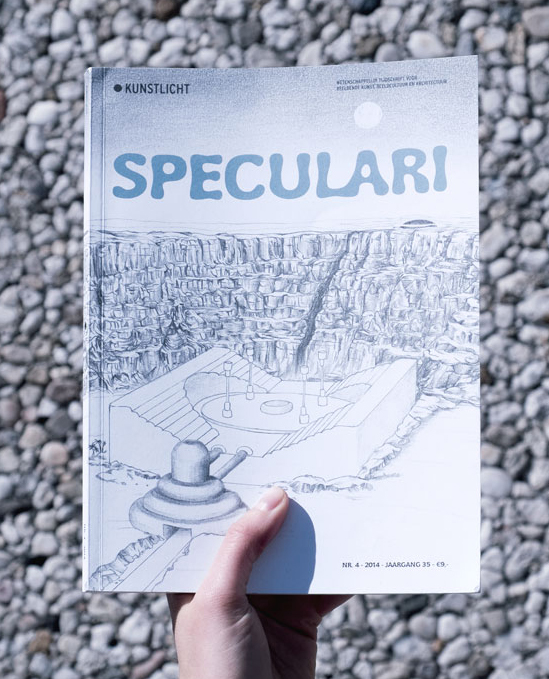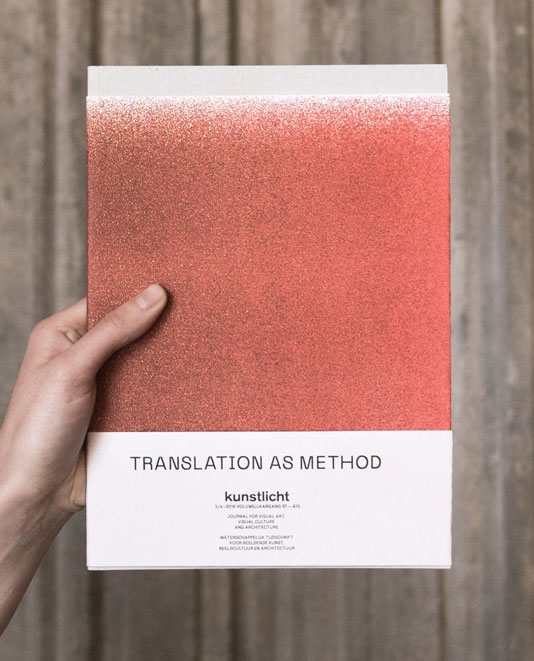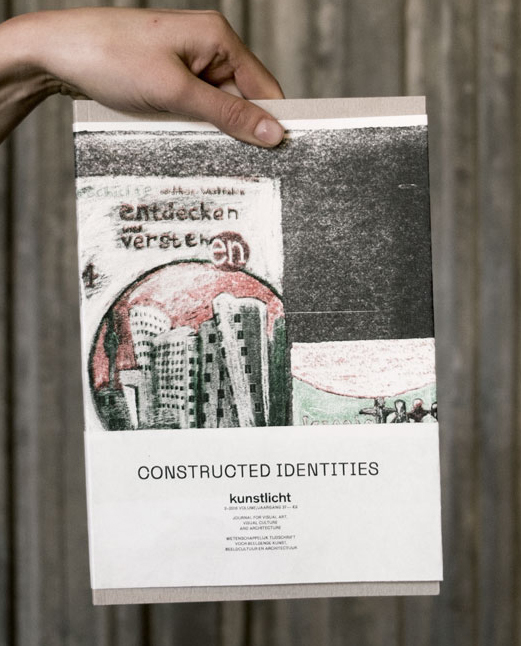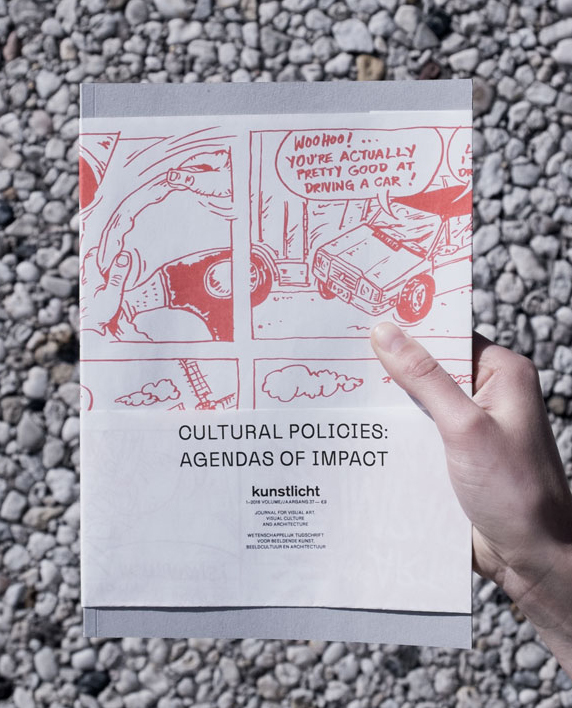Andrew Hewitt
New website
Welcome to Kunstlicht’s new website, designed by Birte Ketting. This website is still under construction.
Stay tuned!
Launch Event: Cultural Policies: Agendas of Impact
Launch Event: Kunstlicht’s ‘Cultural Policies: Agendas of Impact’
Hosted by: Kunstlicht at Framer Framed
Date & Time: 13 September, 19.00-22.00h
Language: English
Admission: Free. Please bring cash to purchase our latest issue (€ 9) or back issues.
On the 13th of September, Kunstlicht will present its latest issue entitled, ‘Cultural Policies: Agendas of Impact’, edited in collaboration with Lara Garcia Diaz and Cristina Marques. The launch event, hosted by Framer Framed, will feature a full program in relation to the theme of the issue, and will culminate with a hosted debate on cultural policies and funding programmes such as The Art of Impact.
The Art of Impact was launched at the end of 2014 by the Dutch Ministry of Culture (OCW) as a temporary funding programme for arts and culture. The programme intends to support artist-initiated projects that have a distinct ‘impact’ on society. Ideologically, The Art of Impact steers away from characterizations of the arts as a left-wing hobby, to rebrand the arts instead as a tool of intervention and engagement with society.
Kunstlicht finds it essential to initiate a debate about such arts funding policies. We want to question the implicit agenda of cultural policies that ultimately use creativity and innovation to fuel neoliberal aims and discourse. This topic surfaced earlier this summer during the debate we organized in relation to the closing of the SMBA. At Framer Framed, we would like to use our issue launch event to continue this debate and offer various perspectives.
The evening will consist of presentations by Bram Ieven and Ruben Pater, a moderated debate with Ieven and Pater; a performance by Angela Bartholomew, and a public discussion. Of course, our latest issue, as well as back issues, will be available for purchase during this event.
Guest speakers:
Bram Ieven lectures on Dutch Literature and Culture at the University of Leiden. He is working on a book about De Stijl. Furthermore, he studies historical figures of Dutch Communism, such as Anton Pannekoek and Herman Gorter, as well as the relationship between Dutch culture and globalization.
Ruben Pater is a graphic designer and lecturer at various design academies in the Netherlands. Under the name Untold Stories (www.untold-stories.net) Ruben Pater creates visual narratives about geopolitical issues. His book The Politics of Design: A (Not So) Global Manual for Visual Communication (2016) addresses the responsibilities of designers in a cross-cultural society.
Moderator:
Sven Lütticken is an art historian and critic. He teaches at the Vrije Universiteit Amsterdam. His recent books include History in Motion: Time in the Age of the Moving Image (2013) and Idols of the Market: Modern Iconoclasm and the Contemporary Spectacle (2009).
Lecture Performance:
‘Save the Arts: They’re Inherently Valuable … and they’re also what’s Going to Get Us Out of This Economic Problem We’re In’, by Angela Bartholomew
Angela is a PhD candidate in the art history department of the Vrije Universiteit Amsterdam. She is writing her dissertation on various artistic strategies utilized by artists in the 1980s and 1990s to navigate the strictures of an increasingly mediatized and market-driven art field. Parallel to her academic studies, Angela conducts performance lectures on the danger of qualifying art by its socially viable functionality.
37 Cultural Policies: Agendas of Impact – editorial
artikel 2
Lorem ipsum dolor sit amet, consectetur adipiscing elit. Maecenas dictum, lectus non scelerisque congue, sem dolor accumsan dolor, et mattis augue nibh a libero. Nulla tincidunt ultrices efficitur. Lorem ipsum dolor sit amet, consectetur adipiscing elit. Ut in fermentum erat. Curabitur non leo libero. Nam sed diam eu orci tristique cursus et vel sapien. Praesent id dui eu massa tempus vestibulum. Aenean pharetra pellentesque ligula sit amet tincidunt. Donec in nulla nisi. Sed id euismod nisl, at lacinia sem. Praesent porttitor nisi nec nulla congue, non venenatis mi pulvinar. Duis feugiat, sem non porttitor feugiat, justo odio rutrum lacus, quis porta augue felis at est. Class aptent taciti sociosqu ad litora torquent per conubia nostra, per inceptos himenaeos. In vel porta elit. Duis sed erat blandit, ullamcorper nibh non, vestibulum sapien. Ut eu erat id sapien aliquet vehicula.
Morbi eu mauris quis massa porttitor tincidunt eget a metus. Vivamus nec odio nec erat tempus convallis vitae in nibh. Morbi sodales nisl at arcu placerat porta. Nulla sodales fringilla dolor, a commodo ligula ultricies eget. Donec vulputate tristique fermentum. Nullam turpis mi, blandit hendrerit posuere sit amet, euismod viverra enim. Orci varius natoque penatibus et magnis dis parturient montes, nascetur ridiculus mus. Sed et egestas diam. Morbi venenatis sit amet est vel efficitur. Vestibulum vulputate vel mauris tincidunt faucibus.
In quis mi nec est auctor mattis. Fusce consequat turpis sed lacus vulputate faucibus at a ligula. Nulla purus nibh, accumsan id tellus ac, ornare tincidunt nisl. Sed feugiat quam eu pretium pretium. Morbi euismod magna mi. Sed accumsan non purus et viverra. Ut vitae magna nulla. Phasellus egestas finibus tortor, in eleifend nulla porttitor non. Nullam vulputate ut lacus at rutrum.
Aenean vitae mi urna. Nunc ullamcorper eget eros varius eleifend. Praesent vel ultricies leo. Phasellus tempor faucibus erat, et ultricies velit bibendum a. Nunc interdum lorem libero, non bibendum massa vestibulum ut. Sed ullamcorper eget erat id placerat. Cras ullamcorper vestibulum erat in aliquet.
Aenean pretium euismod pulvinar. Cras auctor nec sem quis venenatis. Morbi odio metus, sollicitudin sit amet est sit amet, vulputate aliquam diam. Nunc sagittis velit id nunc malesuada auctor. Donec dignissim accumsan lorem. Etiam cursus nunc tellus, non viverra lectus varius laoreet. Sed quis rhoncus eros. Maecenas in massa urna. Aliquam purus magna, tristique sed sapien sit amet, blandit efficitur lectus. Sed non eros dignissim, rutrum arcu at, fringilla ligula. Quisque malesuada, arcu eu auctor ultricies, nulla tortor congue ante, vitae pellentesque velit elit eget mi. Nulla sagittis diam sem, et fermentum ante accumsan at. Donec maximus ligula nibh, eu congue turpis fringilla at. Vivamus luctus, nunc vel lobortis lacinia, nunc dolor finibus elit, eget lacinia diam ligula convallis urna. Quisque blandit enim augue, a gravida tellus consectetur ut.
Integer finibus nibh ut augue condimentum, quis luctus est aliquet. Donec placerat vehicula posuere. In sapien risus, faucibus gravida diam non, tincidunt molestie metus. Etiam luctus lectus nulla, quis sagittis augue pharetra sed. Donec tempor, velit sed finibus egestas, quam ante malesuada augue, in pretium magna lorem id nisi. Nam tempor nisl neque, ut ornare massa pulvinar in. Sed a mattis magna. Pellentesque venenatis nisl eu nunc feugiat vehicula. Nullam at neque justo. Aliquam condimentum turpis diam, quis porta turpis tincidunt at. Donec imperdiet non neque lacinia aliquam. Proin gravida bibendum lectus molestie rhoncus. Morbi congue volutpat nisl non rutrum. Sed aliquam sodales diam sed hendrerit.
Sed vestibulum pellentesque ullamcorper. Aenean tincidunt fringilla aliquet. Nulla nec iaculis velit, ut pretium dui. Pellentesque sit amet nibh nunc. Curabitur non nulla at quam iaculis iaculis sed vitae libero. Praesent ultricies condimentum dictum. Nulla et purus consequat, tempus enim eget, sollicitudin est. Morbi tempus porta augue, sed iaculis velit tempus non. Nunc enim tellus, ultricies mattis tempor sed, venenatis in enim. Aliquam et ultrices felis. In eu metus augue. Class aptent taciti sociosqu ad litora torquent per conubia nostra, per inceptos himenaeos. Vivamus non lorem nulla. Aliquam in libero eget neque vehicula condimentum. Pellentesque faucibus orci suscipit lectus pharetra, at venenatis sem commodo.
Praesent iaculis tristique libero, eget euismod odio dictum vitae. Quisque non purus euismod, semper leo sed, vehicula lorem. Suspendisse luctus id nunc feugiat pharetra. Curabitur pellentesque nibh enim, vel ultrices eros pulvinar at. Donec sagittis dui nunc, a maximus risus mollis viverra. Phasellus scelerisque vehicula ligula eget egestas. Duis dictum in orci vitae dignissim. Maecenas vehicula neque vel turpis cursus, at accumsan eros imperdiet. Donec eu nisi pulvinar, vulputate lorem eget, suscipit neque. Proin posuere euismod euismod. Vivamus semper quis justo vel condimentum. Aenean dolor lacus, scelerisque eu libero id, rutrum posuere leo. Cras odio dolor, tincidunt ut neque sed, aliquam pretium elit. Suspendisse egestas lectus ut risus scelerisque vehicula. Nam pharetra sem metus, eu molestie sapien facilisis blandit.
Call for papers: Mediated Imagination: Technologies Touching upon Art
Call for papers
Mediated Imaginations: Technologies Touching Upon Art
Kunstlicht Vol 38 (2017) 3/4.
Guest editors: Bas de Boer, Sam Edens, Jonne Hoek
Deadline proposals: 07-07-2017
Throughout history, artistic practices have been intimately connected with tools and technologies. Today, techniques and (high-tech) technologies multiply, offering new possibilities for artistic expression. These technological developments raise questions as to what extent technologies touch upon art, how tools and technologies are embedded in or form part of artistic practice, and how technologies mediate imagination. In the philosophy of technology, the term ‘mediation’ is used to express the idea that technologies and human actions mutually constitute each other (Don Ihde, Peter-Paul Verbeek). This idea gave rise to an empirically oriented approach that focuses on concrete technologies, and asks: how does a person relate to the world through these technologies? In this special issue, Kunstlicht explores the mediating function of technologies in relation to imagination, creativity, and art.
We are commonly predisposed to think of technology and imagination as distinct from one another. Artistic imagination is often associated with individuality, freedom, and creativity, while technology is thought of in terms of servitude, generality, and uniformity (Martin Heidegger, Max Horkheimer & Theodor Adorno). However, by focusing on concrete technologies, philosophers of technology currently study the connections between humans, technologies, and the life-world (Bruno Latour, Don Ihde, Langdon Winner), and stress their intimate nature (Donna Haraway, Jean-Luc Nancy). Building on these approaches, a philosophy of technological mediation is interested in how technologies guide our actions in – and understanding of – the world (Peter-Paul Verbeek).
From this perspective, tools and technologies in art are not considered in terms of their medium specificity (Clement Greenberg), and neither is technology ‘the message’ itself (Marshall McLuhan). Even a declared ‘post-medium condition’ cannot sidestep technologies, since only through critical reflection can we “grasp the inner complexity of the mediums” (Rosalind Krauss), to reveal their differential potential. This we also see happening in current artistic practices. Technologies can be a central aspect of the artwork (e.g. software-based art, interactive installations, or Jean Tinguely’s kinetic sculptures), making the aesthetics of certain tools or technologies visible as part of an artistic repertoire. Some artists center their work on human-technology relations (Yvonne Dröge-Wendel, Esther Polak), while other artists use or extend the human body as a tool (Stelarc, Jaime del Val), or critically question collective technological imaginaries (Hito Steyerl, Perry Hoberman).
Kunstlicht aims to investigate how a philosophy of technological mediation might shed new light on the constitution of the artist’s imagination, specific practices, or possibilities for artistic expression. How is art mediated by technological means? How have technologies been the fabric of expression in (e.g.) Romantic, or pop art? How has the digitalization of media of expression reshaped the artist’s imagination? How have specific techniques inspired the work of specific artists? How do technologies help to create a meaningful environment for artistic expression? And how might the philosophy of technology, art history, and aesthetics converge here?
Writers and artists are invited to reflect upon tools and technologies as mediating the imagination in artistic practices, both present and past. We are keenly interested in case studies about the relation between artists and the tools and technologies they use, but also welcome historical contributions and more theoretical reflections.
Proposals (200-300 words) with attached résumés can be submitted until 07-07-2017 via redactie@tijdschriftkunstlicht.nl. Selected authors will be invited to write a 2,000-3,000-word paper (excluding notes). Alternatively, we also welcome short reflections focusing on a specific tool or technology. In these 500 word-contributions, the tool or technology may feature as muse, as companion, as intimate part or as inevitable nuisance. Short reflections may be written in full (max. 500 words) and can also be submitted until 07-07-2017.
Papers may be written either in English or in Dutch. Authors who publish in Kunstlicht will receive three complementary copies. Kunstlicht does not provide an author’s honorarium. Two years following publication, papers will be submitted to the freely accessible online archive.
Vol. 37, 2016 no. 3/4, Translation as Method
With increasing frequency over the years, artists have been testing the nature and strength of the agreements between bodies – agreements that have been formed (or deformed) by attempts to communicate. Connecting the tail of 2016 to the head of 2017 with an issue on artistic approaches to translation affirms our faith in the necessity of a practice that persistently attempts to communicate across languages, disciplines, generations, and ideologies.
Continue reading “Vol. 37, 2016 no. 3/4, Translation as Method”
Vol. 37, 2016, no. 2, Constructed Identities
Constructed Identities takes you on a trip through Europe and a little beyond — a journey through space, as well as time. The issue (edited by Rosa te Velde) explores a selection of case studies to consider the selective uses of history in heritage, and it puts forth alternative approaches to question established definitions of identity. Featuring articles by Lila Athanasiadou, Isa Fahrenholz and Svenja Binz, Abla elBahrawy, Arna Mackic, Katinka de Jonge, and interviews with Jennifer Tosch and Wendelien van Oldenborgh. Artworks by Guy Köningstein, and on the cover a drawing by the Georgian artist Lado Darakhvelidze.
Continue reading “Vol. 37, 2016, no. 2, Constructed Identities”
Vol. 37, 2016, no. 1, Cultural Policies Agendas of Impact
Table of Contents Cultural Policies: Agendas of Impact
p.2 Editorial Rosa te Velde & Steyn Bergs
p.3 Introduction Lara Garcia Diaz & Cristina Marques Mo
ran
p.9 Bram Ieven Opbouw als afbraak: over democratisering als
vanishing
mediator in het huidige kunstenbeleid
p.9 Bram Ieven Desctructive Construction: Democratization
as a
Vanishing
Mediator
in current Dutch art policy
p.17 Steven ten Thije
The Art of Impact
: Aspirin for Amputation
p.20
The Art of Impact
Programme: Interview with Tabo Goudswaard and Michiel
Munnike
p.25 Josephine Berry Agents or Objects of Discontinuous Chan
ge? Blairite Britain
and the Role of the Culturepreneur
p.37 Sven Lütticken Ends of Art: from Nul to Bijl
p.45 Market for Immaterial Value & Steyn Bergs Value is an
Ambigious
Hyperobject
p.50 Putting Ourselves at Risk in Public: Interview with Jeanne van He
eswijk
p.56 Management of Distrust: Measuring and Monitoring in Pol
icy making: Interview with
Pascal Gielen
p.62 Abstracts
p.64 Colofon




